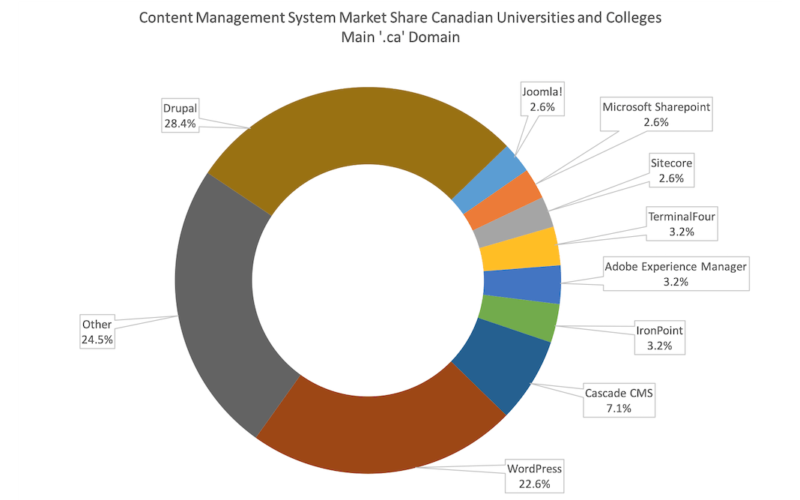Published on January 15, 2019
NOTE FROM THE #PSEWEB EDITORIAL TEAM: Happy New Year, #PSEWEB Community! Our first post back is a guest article from eQAfy’s Paul Bradley about the use of content management systems by Canadian universities and colleges. eQAfy, a web estate monitoring service to boost higher education website user experiences, content quality and accessibility, is one of our many exciting vendors for the 2019 #PSEWEB conference.
Written by Paul Bradley
eQAfy, Data for better higher education websites and digital governance

Following on from our earlier update to the content management systems (CMS) UK higher education institutions use, we’ve updated the equivalent information for Canada’s university and other degree-awarding institutions.
We used our web estate registry application to detect the CMSs publishing content on the main ‘.ca’ domains for 172 Canadian higher education websites. We use non-intrusive techniques to resolve which CMS is generating a page’s content. This approach limits detection, but is consistent with ‘respectful’ use of a web server.
Consequently, we unambiguously identified only 90% of the CMSs in the survey group of 172 universities and colleges. [We’ll follow up by email to identify the balance of the systems.]
We detected 35 different CMSs across the 155 institutions for which we have a high degree of confidence in our CMS detection. In contrast, our UK higher education institutions used 27 different CMSs across 152 institutions.
We’ve plotted the implied Canadian university CMS market share data in the doughnut chart below.
The Canadian higher education CMS market shows more concentration than the UK and much higher reliance on open-source solutions. In Canada, three ‘suppliers’ account for just under 60% of the systems used to publish content on main university and college websites. In the UK, five suppliers account for two-thirds of installed systems.

Canadian higher education institutions make more use of one-off content management systems than their UK counterparts: potentially increasing exposure to obsolete technology and platforms with unclear future development paths. We note that two smaller institutions have opted for off-the-shelf hosted website solutions, likely minimizing development resources in favour of content creation.
Canadian institutions also rely more heavily on open-source software (WordPress and Drupal) from which one may speculate a greater emphasis on content publishing than support for digital marketing that would be provided by higher education-specific content management systems.
Note that we only ‘tested’ the content management system rendering content on each institution’s main domain home page. Extrapolating these statistics into wider market share estimates is likely to be unreliable. Our work reviewing individual institutions’ sub- and micro-sites confirms that school, faculty and department websites predominantly use Drupal and WordPress rather than the other 33 CMSs we detected in this exercise.
Finally, two suppliers potentially under-represented in this survey are TerminalFour and Sitecore, both of which have a growing presence with higher education institutions in the US and UK and will be making shortlists in Canadian CMS selection exercises.
This article originally appeared on eQAfy.